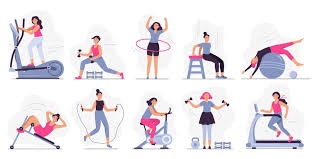Physical fitness is the cornerstone of a healthy, vibrant life in 2024. As lifestyles become increasingly sedentary, prioritizing physical fitness—encompassing strength, endurance, flexibility, and body composition—is essential for combating chronic diseases, enhancing mental clarity, and improving longevity. Whether you’re a fitness novice or a seasoned athlete, this guide explores actionable strategies to elevate your physical fitness journey. From tailored workout routines to nutrition tips and mental health connections, discover how to unlock your full potential. Let’s dive into the science-backed methods to transform your health and vitality this year.

Why Physical Fitness is Essential for Long-Term Health
Physical fitness is not just about aesthetics; it’s a lifeline for long-term health. Regular exercise reduces the risk of heart disease, diabetes, and obesity while strengthening bones and muscles. Studies show that physically fit individuals experience 30% lower rates of premature death. Beyond physical benefits, fitness enhances mental health by releasing endorphins, reducing anxiety, and improving cognitive function. In 2024, as stress levels rise globally, prioritizing physical fitness can combat burnout and boost immunity. Whether it’s a brisk walk or a gym session, staying active is a non-negotiable pillar of holistic wellness.
Top 5 Types of Physical Fitness Exercises You Need to Try
Diversifying workouts is key to well-rounded physical fitness. **Cardio** (running, cycling) improves heart health, **strength training** (weightlifting) builds muscle mass, and **flexibility exercises** (yoga) enhance mobility. **Balance workouts** (Tai Chi) prevent falls, especially in seniors, while **HIIT** (High-Intensity Interval Training) torches calories efficiently. Combining these forms prevents plateaus and keeps workouts engaging. For instance, alternating between HIIT and yoga balances intensity with recovery. In 2024, hybrid routines are trending—blend these exercises to tailor a regimen that aligns with your physical fitness goals.
How to Create a Personalized Physical Fitness Routine
A personalized physical fitness routine considers your age, goals, and lifestyle. Start by assessing your current fitness level and defining SMART goals (Specific, Measurable, Achievable, Relevant, Time-bound). For weight loss, prioritize cardio and strength training; for flexibility, incorporate daily stretching. Busy professionals might opt for 20-minute home workouts, while retirees could focus on low-impact activities like swimming. Apps like MyFitnessPal or FitOn offer customizable plans. Schedule workouts during peak energy times (e.g., mornings for early birds) and gradually increase intensity. Remember, consistency trumps perfection—even 150 minutes weekly of moderate exercise reaps significant benefits.
The Role of Nutrition in Achieving Physical Fitness Goals
Nutrition fuels physical fitness success. Protein repairs muscles post-workout (aim for 1.2–2.2g/kg of body weight), while complex carbs (oats, quinoa) provide sustained energy. Hydration is critical—dehydration can reduce performance by 20%. Superfoods like spinach, berries, and nuts deliver antioxidants to combat exercise-induced inflammation. Time meals strategically: eat a carb-rich snack 30 minutes before workouts and protein within 45 minutes post-exercise. In 2024, plant-based diets are gaining traction for their heart-healthy benefits. Remember, no amount of exercise can outpace poor nutrition—balance macros and prioritize whole foods for optimal results.
Physical Fitness and Mental Health: The Surprising Connection
Physical fitness is a powerful antidote to mental health struggles. Exercise reduces cortisol (the stress hormone) and increases serotonin and dopamine, alleviating symptoms of depression and anxiety. A 2023 study found that 45 minutes of aerobic exercise three times weekly reduces anxiety by 26%. Group workouts also foster social connections, combating loneliness. Practices like yoga and Pilates integrate mindfulness, enhancing emotional resilience. In an era where 1 in 5 adults face mental health challenges, physical fitness serves as a accessible, cost-effective therapy. Prioritize movement to sharpen focus, improve sleep, and cultivate a positive mindset.
Common Physical Fitness Mistakes (And How to Avoid Them)
Overtraining, poor form, and skipping recovery are pitfalls that derail physical fitness progress. Overtraining leads to injuries and burnout—listen to your body and incorporate rest days. Poor form during squats or deadlifts risks spinal injuries; work with a trainer to perfect technique. Neglecting recovery (sleep, stretching, foam rolling) prolongs muscle soreness and hampers growth. Another mistake is fixating on weight loss alone—strength gains and endurance matter too. In 2024, recovery tech like percussion massagers and cryotherapy is trending. Balance effort with recovery to sustain long-term fitness success.
How to Track Progress in Your Physical Fitness Journey
Tracking progress keeps you motivated and accountable. Use wearables like Fitbit or Apple Watch to monitor heart rate, steps, and calories burned. Apps like Strong log strength training progress, while DEXA scans measure body fat percentage. Non-scale victories—like climbing stairs without breathlessness or lifting heavier weights—are equally important. Set monthly benchmarks (e.g., running a 5K or mastering a pull-up) and celebrate milestones. In 2024, AI-powered apps analyze data to recommend personalized adjustments. Remember, progress isn’t linear—plateaus are normal. Stay patient, tweak your routine, and keep the big picture in mind.
Physical Fitness for Different Age Groups: Kids, Adults, and Seniors
Physical fitness needs evolve with age. **Kids** (5–17 years) require 60 minutes daily of play, sports, or biking to build bone density. **Adults** (18–64) should blend cardio, strength training, and flexibility exercises to maintain metabolism and prevent age-related muscle loss. **Seniors** (65+) benefit from balance exercises (chair yoga) and low-impact cardio (swimming) to protect joints. Family workouts, like weekend hikes, promote bonding and lifelong fitness habits. In 2024, adaptive fitness programs cater to all ages, ensuring everyone can stay active safely. Tailor activities to ability levels for sustainable engagement.
Debunking Myths About Physical Fitness
Myths like “No pain, no gain” or “Spot reduction” persist, but science disproves them. Pain signals injury—discomfort during squats is normal, sharp pain is not. Spot reduction is impossible; crunches won’t melt belly fat without overall fat loss. Another myth: “Cardio is better than strength training.” Both are vital—cardio burns calories, while strength training boosts metabolism. Lastly, “You need hours at the gym.” Research shows 15-minute HIIT sessions can be equally effective. In 2024, evidence-based fitness trumps trends—focus on balanced routines and listen to your body.

Sustainable Physical Fitness: How to Stay Motivated Long-Term
Sustainability hinges on habit-building and enjoyment. Choose activities you love—dance, hiking, or martial arts—to avoid burnout. Set micro-goals (e.g., “Walk 10k steps daily”) and reward achievements (a new workout outfit). Social accountability—joining a fitness class or partnering with a friend—boosts consistency. Embrace variety to prevent boredom; try a new sport each season. In 2024, gamified apps like Zombies, Run! make fitness fun. Remember, progress is gradual—aim for 1% improvement daily. Prioritize rest, adapt to life’s changes, and view physical fitness as a lifelong journey, not a sprint.
Conclusion
Physical fitness in 2024 is more than a trend—it’s a necessity for thriving in a fast-paced world. By integrating diverse workouts, personalized nutrition, and mental health practices, you can build resilience, energy, and confidence. Whether you’re a busy parent, a remote worker, or a retiree, small, consistent steps yield transformative results. Embrace the journey, celebrate progress, and remember: every rep, step, and stretch brings you closer to a healthier, happier you. Start today—your future self will thank you.
FAQs
What are the top benefits of physical fitness?**
Improved heart health, stronger muscles, mental clarity, stress reduction, and enhanced longevity.
How often should I exercise for optimal physical fitness?**
Aim for 150 minutes of moderate aerobic activity or 75 minutes of vigorous activity weekly, plus strength training twice a week.
Can I achieve physical fitness without a gym membership?**
Yes! Bodyweight exercises (push-ups, squats), outdoor runs, and online workout videos are effective alternatives.
What’s the best exercise for weight loss?**
HIIT and cardio (running, cycling) burn calories fastest, but combining them with strength training maximizes fat loss.
Is stretching necessary for physical fitness?**
Yes—improves flexibility, prevents injuries, and aids muscle recovery.
How does aging affect physical fitness?**
Muscle mass declines with age, but resistance training and balance exercises can mitigate this.
Can physical fitness improve sleep quality?**
Absolutely—regular exercise regulates sleep cycles and reduces insomnia.
What should I eat before a workout?**
Opt for light, carb-rich snacks (banana, toast) 30–60 minutes prior for energy.
How do I avoid plateaus in my fitness journey?**
Change your routine every 6–8 weeks—increase weights, try new exercises, or adjust intensity.
Is it safe to exercise during pregnancy?**
Yes, with medical approval. Focus on low-impact activities like swimming, prenatal yoga, and walking.